Factoring
Factor Trinomials
Learning Objectives
By the end of this section, you will be able to:
- Factor trinomials of the form

- Factor trinomials of the form
 using trial and error
using trial and error - Factor trinomials of the form
 using the ‘ac’ method
using the ‘ac’ method - Factor using substitution
Before you get started, take this readiness quiz.
Factor Trinomials of the Form 
You have already learned how to multiply binomials using FOIL. Now you’ll need to “undo” this multiplication. To factor the trinomial means to start with the product, and end with the factors.
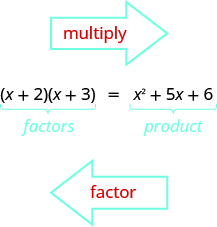
To figure out how we would factor a trinomial of the form ![]() such as
such as ![]() and factor it to
and factor it to ![]() let’s start with two general binomials of the form
let’s start with two general binomials of the form ![]() and
and ![]()
 |
|
| Foil to find the product. |  |
| Factor the GCF from the middle terms. |  |
| Our trinomial is of the form |
 |
This tells us that to factor a trinomial of the form ![]() we need two factors
we need two factors ![]() and
and ![]() where the two numbers m and n multiply to c and add to b.
where the two numbers m and n multiply to c and add to b.
Factor: ![]()




Factor: ![]()
![]()
Factor: ![]()
![]()
Let’s summarize the steps we used to find the factors.
- Write the factors as two binomials with first terms x.

- Find two numbers m and n that
- multiply to

- add to

- multiply to
- Use m and n as the last terms of the factors.

- Check by multiplying the factors.
In the first example, all terms in the trinomial were positive. What happens when there are negative terms? Well, it depends which term is negative. Let’s look first at trinomials with only the middle term negative.
How do you get a positive product and a negative sum? We use two negative numbers.
Factor: ![]()
Again, with the positive last term, 28, and the negative middle term, ![]() we need two negative factors. Find two numbers that multiply 28 and add to
we need two negative factors. Find two numbers that multiply 28 and add to ![]()

| Factors of |
Sum of factors |
|---|---|
|
|

Factor: ![]()
![]()
Factor: ![]()
![]()
Now, what if the last term in the trinomial is negative? Think about FOIL. The last term is the product of the last terms in the two binomials. A negative product results from multiplying two numbers with opposite signs. You have to be very careful to choose factors to make sure you get the correct sign for the middle term, too.
How do you get a negative product and a positive sum? We use one positive and one negative number.
When we factor trinomials, we must have the terms written in descending order—in order from highest degree to lowest degree.
Factor: ![]()

| Factors of |
Sum of factors |
|---|---|
|
|

Factor: ![]()
![]()
Factor: ![]()
![]()
Sometimes you’ll need to factor trinomials of the form ![]() with two variables, such as
with two variables, such as ![]() The first term,
The first term, ![]() is the product of the first terms of the binomial factors,
is the product of the first terms of the binomial factors, ![]() The
The ![]() in the last term means that the second terms of the binomial factors must each contain y. To get the coefficients b and c, you use the same process summarized in How To Factor trinomials.
in the last term means that the second terms of the binomial factors must each contain y. To get the coefficients b and c, you use the same process summarized in How To Factor trinomials.
Factor: ![]()
We need r in the first term of each binomial and s in the second term. The last term of the trinomial is negative, so the factors must have opposite signs.

| Factors of |
Sum of factors |
|---|---|

Factor: ![]()
![]()
Factor: ![]()
![]()
Some trinomials are prime. The only way to be certain a trinomial is prime is to list all the possibilities and show that none of them work.
Factor: ![]()
We need u in the first term of each binomial and v in the second term. The last term of the trinomial is negative, so the factors must have opposite signs.

| Factors of |
Sum of factors |
|---|---|
|
|
Note there are no factor pairs that give us ![]() as a sum. The trinomial is prime.
as a sum. The trinomial is prime.
Factor: ![]()
prime
Factor: ![]()
prime
Let’s summarize the method we just developed to factor trinomials of the form ![]()
When we factor a trinomial, we look at the signs of its terms first to determine the signs of the binomial factors.
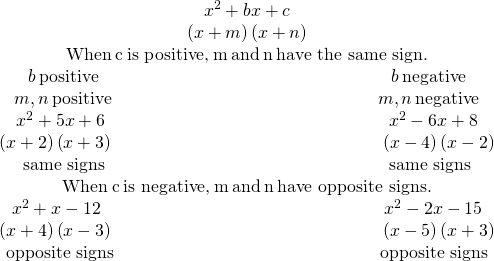
Notice that, in the case when m and n have opposite signs, the sign of the one with the larger absolute value matches the sign of b.
Factor Trinomials of the form ax2 + bx + c using Trial and Error
Our next step is to factor trinomials whose leading coefficient is not 1, trinomials of the form ![]()
Remember to always check for a GCF first! Sometimes, after you factor the GCF, the leading coefficient of the trinomial becomes 1 and you can factor it by the methods we’ve used so far. Let’s do an example to see how this works.
Factor completely: ![]()

| Factors of |
Sum of factors |
|---|---|
|
|
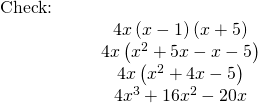
Factor completely: ![]()
![]()
Factor completely: ![]()
![]()
What happens when the leading coefficient is not 1 and there is no GCF? There are several methods that can be used to factor these trinomials. First we will use the Trial and Error method.
Let’s factor the trinomial ![]()
From our earlier work, we expect this will factor into two binomials.
We know the first terms of the binomial factors will multiply to give us ![]() The only factors of
The only factors of ![]() are
are ![]() We can place them in the binomials.
We can place them in the binomials.

Check: Does ![]()
We know the last terms of the binomials will multiply to 2. Since this trinomial has all positive terms, we only need to consider positive factors. The only factors of 2 are 1, 2. But we now have two cases to consider as it will make a difference if we write 1, 2 or 2, 1.

Which factors are correct? To decide that, we multiply the inner and outer terms.
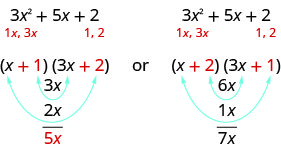
Since the middle term of the trinomial is ![]() the factors in the first case will work. Let’s use FOIL to check.
the factors in the first case will work. Let’s use FOIL to check.

Our result of the factoring is:
Factor completely using trial and error: ![]()




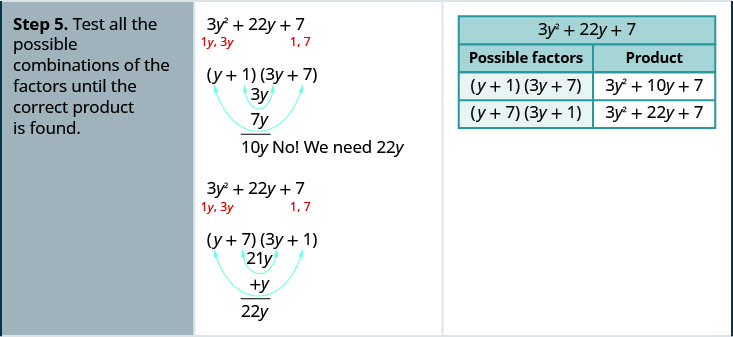

Factor completely using trial and error: ![]()
![]()
Factor completely using trial and error: ![]()
![]()
- Write the trinomial in descending order of degrees as needed.
- Factor any GCF.
- Find all the factor pairs of the first term.
- Find all the factor pairs of the third term.
- Test all the possible combinations of the factors until the correct product is found.
- Check by multiplying.
Remember, when the middle term is negative and the last term is positive, the signs in the binomials must both be negative.
Factor completely using trial and error: ![]()
| The trinomial is already in descending order. |  |
| Find the factors of the first term. |  |
| Find the factors of the last term. Consider the signs.
Since the last term, 5, is positive its factors must both be positive or both be negative. The coefficient of the middle term is negative, so we use the negative factors. |
 |
Consider all the combinations of factors.
| Possible factors | Product |
|---|---|

Factor completely using trial and error: ![]()
![]()
Factor completely using trial and error: ![]()
![]()
When we factor an expression, we always look for a greatest common factor first. If the expression does not have a greatest common factor, there cannot be one in its factors either. This may help us eliminate some of the possible factor combinations.
Factor completely using trial and error: ![]()
| The trinomial is already in descending order. |  |
| Find the factors of the first term. |  |
| Find the factors of the last term. Consider the signs.
Since 15 is positive and the coefficient of the middle term is negative, we use the negative factors. |
 |
Consider all the combinations of factors.


Factor completely using trial and error ![]()
![]()
Factor completely using trial and error: ![]()
![]()
Don’t forget to look for a GCF first and remember if the leading coefficient is negative, so is the GCF.
Factor completely using trial and error: ![]()
 |
|
| Notice the greatest common factor, so factor it first. |  |
| Factor the trinomial. |  |
Consider all the combinations.
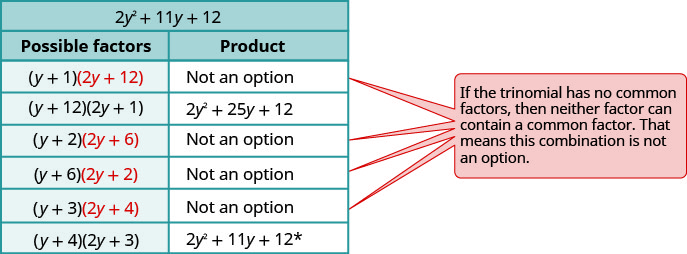
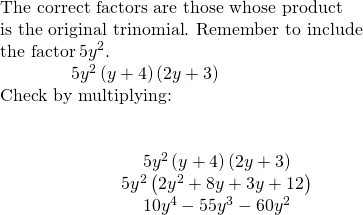
Factor completely using trial and error: ![]()
![]()
Factor completely using trial and error: ![]()
![]()
Factor Trinomials of the Form  using the “ac” Method
using the “ac” Method
Another way to factor trinomials of the form ![]() is the “ac” method. (The “ac” method is sometimes called the grouping method.) The “ac” method is actually an extension of the methods you used in the last section to factor trinomials with leading coefficient one. This method is very structured (that is step-by-step), and it always works!
is the “ac” method. (The “ac” method is sometimes called the grouping method.) The “ac” method is actually an extension of the methods you used in the last section to factor trinomials with leading coefficient one. This method is very structured (that is step-by-step), and it always works!
Factor using the ‘ac’ method: ![]()






Factor using the ‘ac’ method: ![]()
![]()
Factor using the ‘ac’ method: ![]()
![]()
The “ac” method is summarized here.
- Factor any GCF.
- Find the product ac.
- Find two numbers m and n that:

- Split the middle term using m and n.

- Factor by grouping.
- Check by multiplying the factors.
Don’t forget to look for a common factor!
Factor using the ‘ac’ method: ![]()
| Is there a greatest common factor? | ||
| Yes. The GCF is 5. |  |
|
| Factor it. |  |
|
| The trinomial inside the parentheses has a
leading coefficient that is not 1. |
 |
|
| Find the product |
||
| Find two numbers that multiply to |
||
| and add to b. | ||
| Split the middle term. |  |
|
 |
||
| Factor the trinomial by grouping. |  |
|
 |
||
| Check by multiplying all three factors.
|
Factor using the ‘ac’ method: ![]()
![]()
Factor using the ‘ac’ method: ![]()
![]()
Factor Using Substitution
Sometimes a trinomial does not appear to be in the ![]() form. However, we can often make a thoughtful substitution that will allow us to make it fit the
form. However, we can often make a thoughtful substitution that will allow us to make it fit the ![]() form. This is called factoring by substitution. It is standard to use u for the substitution.
form. This is called factoring by substitution. It is standard to use u for the substitution.
In the ![]() the middle term has a variable, x, and its square,
the middle term has a variable, x, and its square, ![]() is the variable part of the first term. Look for this relationship as you try to find a substitution.
is the variable part of the first term. Look for this relationship as you try to find a substitution.
Factor by substitution: ![]()
The variable part of the middle term is ![]() and its square,
and its square, ![]() is the variable part of the first term. (We know
is the variable part of the first term. (We know ![]() If we let
If we let ![]() we can put our trinomial in the
we can put our trinomial in the ![]() form we need to factor it.
form we need to factor it.
 |
|
| Rewrite the trinomial to prepare for the substitution. |  |
| Let |
 |
| Factor the trinomial. |  |
| Replace u with |
 |
| Check:
|
Factor by substitution: ![]()
![]()
Factor by substitution: ![]()
![]()
Sometimes the expression to be substituted is not a monomial.
Factor by substitution: ![]()
The binomial in the middle term, ![]() is squared in the first term. If we let
is squared in the first term. If we let ![]() and substitute, our trinomial will be in
and substitute, our trinomial will be in ![]() form.
form.
 |
|
| Rewrite the trinomial to prepare for the substitution. |  |
| Let |
 |
| Factor the trinomial. |  |
| Replace u with |
 |
| Simplify inside the parentheses. |  |
This could also be factored by first multiplying out the ![]() and the
and the ![]() and then combining like terms and then factoring. Most students prefer the substitution method.
and then combining like terms and then factoring. Most students prefer the substitution method.
Factor by substitution: ![]()
![]()
Factor by substitution: ![]()
![]()
Access this online resource for additional instruction and practice with factoring.
Key Concepts
- How to factor trinomials of the form

- Write the factors as two binomials with first terms x.

- Find two numbers m and n that

- Use m and n as the last terms of the factors.

- Check by multiplying the factors.
- Write the factors as two binomials with first terms x.
- Strategy for Factoring Trinomials of the Form
 : When we factor a trinomial, we look at the signs of its terms first to determine the signs of the binomial factors.
: When we factor a trinomial, we look at the signs of its terms first to determine the signs of the binomial factors.
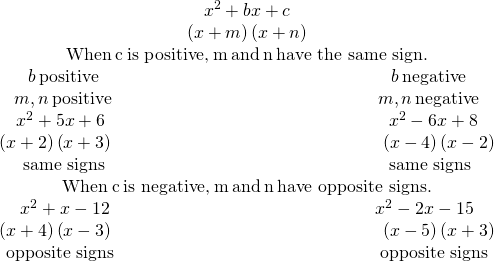
Notice that, in the case when m and n have opposite signs, the sign of the one with the larger absolute value matches the sign of b.
- How to factor trinomials of the form
 using trial and error.
using trial and error.
- Write the trinomial in descending order of degrees as needed.
- Factor any GCF.
- Find all the factor pairs of the first term.
- Find all the factor pairs of the third term.
- Test all the possible combinations of the factors until the correct product is found.
- Check by multiplying.
- How to factor trinomials of the form
 using the “ac” method.
using the “ac” method.
- Factor any GCF.
- Find the product ac.
- Find two numbers m and n that:

- Split the middle term using m and n.

- Factor by grouping.
- Check by multiplying the factors.
Practice Makes Perfect
Factor Trinomials of the Form ![]()
In the following exercises, factor each trinomial of the form ![]()
![]()
![]()
![]()
![]()
![]()
![]()
![]()
![]()
![]()
![]()
![]()
![]()
![]()
![]()
![]()
![]()
![]()
![]()
![]()
![]()
![]()
![]()
![]()
![]()
![]()
![]()
![]()
In the following exercises, factor each trinomial of the form ![]()
![]()
![]()
![]()
![]()
![]()
![]()
![]()
![]()
![]()
![]()
Prime
![]()
![]()
Prime
![]()
Factor Trinomials of the Form ![]() Using Trial and Error
Using Trial and Error
In the following exercises, factor completely using trial and error.
![]()
![]()
![]()
![]()
![]()
![]()
![]()
![]()
![]()
![]()
![]()
![]()
![]()
![]()
![]()
![]()
![]()
![]()
![]()
![]()
![]()
![]()
![]()
![]()
![]()
![]()
![]()
![]()
![]()
![]()
![]()
![]()
![]()
Factor Trinomials of the Form ![]() using the ‘ac’ Method
using the ‘ac’ Method
In the following exercises, factor using the ‘ac’ method.
![]()
![]()
![]()
![]()
![]()
![]()
![]()
![]()
![]()
![]()
![]()
![]()
![]()
![]()
![]()
![]()
![]()
![]()
![]()
![]()
![]()
![]()
![]()
![]()
Factor Using Substitution
In the following exercises, factor using substitution.
![]()
![]()
![]()
![]()
![]()
![]()
![]()
![]()
![]()
![]()
![]()
![]()
Mixed Practice
In the following exercises, factor each expression using any method.
![]()
![]()
![]()
![]()
![]()
![]()
![]()
![]()
![]()
![]()
![]()
![]()
![]()
![]()
![]()
![]()
![]()
![]()
![]()
![]()
![]()
![]()
![]()
![]()
![]()
![]()
![]()
![]()
![]()
![]()
Writing Exercises
Many trinomials of the form ![]() factor into the product of two binomials
factor into the product of two binomials ![]() Explain how you find the values of m and n.
Explain how you find the values of m and n.
Answers will vary.
Tommy factored ![]() as
as ![]() Sara factored it as
Sara factored it as ![]() Ernesto factored it as
Ernesto factored it as ![]() Who is correct? Explain why the other two are wrong.
Who is correct? Explain why the other two are wrong.
List, in order, all the steps you take when using the “ac” method to factor a trinomial of the form ![]()
Answers will vary.
How is the “ac” method similar to the “undo FOIL” method? How is it different?
Self Check
ⓐ After completing the exercises, use this checklist to evaluate your mastery of the objectives of this section.

ⓑ After reviewing this checklist, what will you do to become confident for all objectives?



